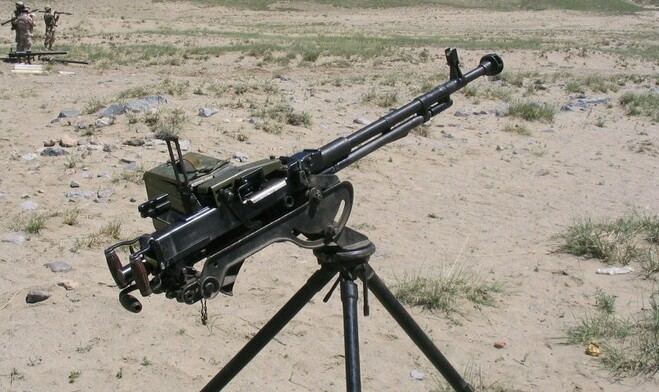In service 1938–present | Used by See Users | |
 | ||
Wars Winter WarWorld War IIKorean WarChinese Civil WarFirst Indochina WarOperation TrikoraIndonesia–Malaysia confrontationVietnam WarLaotian Civil WarDhofar RebellionCambodian Civil WarCambodian-Vietnamese WarSino-Vietnamese WarSix-Day WarYom Kippur WarIran–Iraq WarThe TroublesLebanese Civil WarGulf WarYugoslav WarsKargil WarIraq WarAfghan WarCambodian–Thai border disputeSyrian Civil WarOperation Enduring FreedomOperation Linda Nchi2014 pro-Russian conflict in UkraineSouth African Border War Designer Vasily Degtyaryov, Georgi Shpagin | ||
The DShK 1938 (ДШК, for Дегтярёва-Шпагина Крупнокалиберный, Degtyaryova-Shpagina Krupnokaliberny, 'Degtyaryov-Shpagin Large-Calibre') is a Soviet heavy machine gun firing the 12.7×108mm cartridge. The weapon was also used as a heavy infantry machine gun, in which case it was frequently deployed with a two-wheeled mounting and a single-sheet armour-plate shield. It took its name from the weapons designers Vasily Degtyaryov, who designed the original weapon, and Georgi Shpagin, who improved the cartridge feed mechanism. It is sometimes nicknamed Dashka (familiar form of female name Daria) in Russian-speaking countries, from the abbreviation.
History
The requirement for a heavy machine gun appeared in 1929. The first such gun, the Degtyaryov, Krupnokalibernyi (DK, Degtyaryov, Large calibre), was built in 1930 and this gun was produced in small quantities from 1933 to 1935.
The gun was fed from a drum magazine of only thirty rounds, and had a poor rate of fire. Shpagin developed a belt feed mechanism to fit to the DK giving rise, in 1938, to the adoption of the gun as the DShK 1938. This became the standard Soviet heavy machine gun in World War II.
Like its U.S. equivalent, the M2 Browning, the DShK 1938 was used in several roles. As an anti-aircraft weapon it was mounted on pintle and tripod mounts, and on a triple mount on the GAZ-AA truck. Late in the war, it was mounted on the cupolas of IS-2 tanks and ISU-152 self-propelled guns. As an infantry heavy support weapon it used a two-wheeled trolley which unfolded into a tripod for anti-aircraft use, similar to the mount developed by Vladimirov for the 1910 Maxim gun. It was also mounted in vehicle turrets, for example, in the T-40 light amphibious tank.
In 1946, the DShK 1938/46 or DShKM (M for modernized) version was introduced.
In addition to the Soviet Union and Russia, the DShK has been manufactured under license by a number of countries, including the People's Republic of China, Pakistan and Romania. Today, it has been mostly replaced in favour of the more modern NSV and Kord designs. Nevertheless, the DShK is still one of the most widely used heavy machine guns.
In June 1988, during the conflict in Northern Ireland known as the Troubles, a British Army Westland Lynx helicopter was hit 15 times by two Provisional IRA DShKs smuggled in from Libya and forced to crash-land near Cashel Lough Upper, south County Armagh.
DShKs were also used in 2004, against British troops in Al-Amarah, Iraq.
In the 2012 Syrian civil war, the Syrian government said rebels used the gun mounted on cars. It claimed to have destroyed, on the same day, 40 such cars on a highway in Aleppo and six in Dael.
